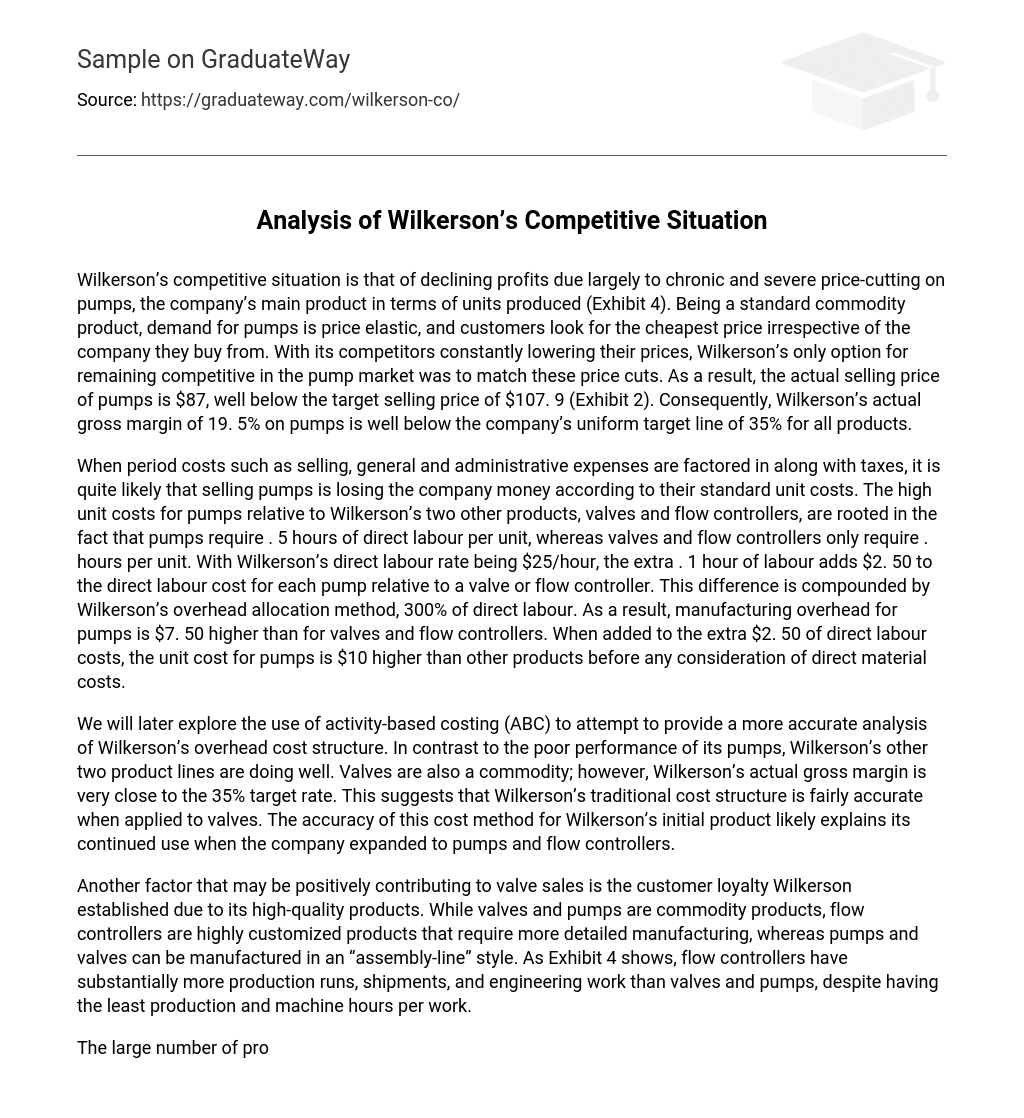Wilkerson’s competitive situation is that of declining profits due largely to chronic and severe price-cutting on pumps, the company’s main product in terms of units produced (Exhibit 4). Being a standard commodity product, demand for pumps is price elastic, and customers look for the cheapest price irrespective of the company they buy from. With its competitors constantly lowering their prices, Wilkerson’s only option for remaining competitive in the pump market was to match these price cuts. As a result, the actual selling price of pumps is $87, well below the target selling price of $107. 9 (Exhibit 2). Consequently, Wilkerson’s actual gross margin of 19. 5% on pumps is well below the company’s uniform target line of 35% for all products.
When period costs such as selling, general and administrative expenses are factored in along with taxes, it is quite likely that selling pumps is losing the company money according to their standard unit costs. The high unit costs for pumps relative to Wilkerson’s two other products, valves and flow controllers, are rooted in the fact that pumps require . 5 hours of direct labour per unit, whereas valves and flow controllers only require . hours per unit. With Wilkerson’s direct labour rate being $25/hour, the extra . 1 hour of labour adds $2. 50 to the direct labour cost for each pump relative to a valve or flow controller. This difference is compounded by Wilkerson’s overhead allocation method, 300% of direct labour. As a result, manufacturing overhead for pumps is $7. 50 higher than for valves and flow controllers. When added to the extra $2. 50 of direct labour costs, the unit cost for pumps is $10 higher than other products before any consideration of direct material costs.
We will later explore the use of activity-based costing (ABC) to attempt to provide a more accurate analysis of Wilkerson’s overhead cost structure. In contrast to the poor performance of its pumps, Wilkerson’s other two product lines are doing well. Valves are also a commodity; however, Wilkerson’s actual gross margin is very close to the 35% target rate. This suggests that Wilkerson’s traditional cost structure is fairly accurate when applied to valves. The accuracy of this cost method for Wilkerson’s initial product likely explains its continued use when the company expanded to pumps and flow controllers.
Another factor that may be positively contributing to valve sales is the customer loyalty Wilkerson established due to its high-quality products. While valves and pumps are commodity products, flow controllers are highly customized products that require more detailed manufacturing, whereas pumps and valves can be manufactured in an “assembly-line” style. As Exhibit 4 shows, flow controllers have substantially more production runs, shipments, and engineering work than valves and pumps, despite having the least production and machine hours per work.
The large number of production runs and hours of engineering work are due to the unique nature of each product, requiring more detailed engineering and different components for each product. Since each flow controller is relatively unique, it is more difficult for Wilkerson to ship in bulk, which explains the fact that over 70% of Wilkerson’s total shipments are allocated to flow controllers. Despite all this, Wilkerson maintains a healthy 41% gross margin on flow controllers, even after raising prices by 10% of the target price.
This is likely due to either a high-quality product relative to its competitors, or the standard unit cost of flow controllers being too low. ABC will allow the standard unit cost of flow controllers to be better assessed, and the reason for the high gross margin of flow controllers will become clear. Overall, Wilkerson is in a precarious competitive situation due to the low gross margin on pumps, and this is the main problem that must be assessed. Since raising prices to increase revenue is not an option with a commodity, cost of sales must be reduced in order to increase gross margin.





